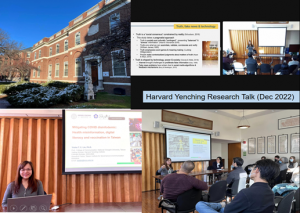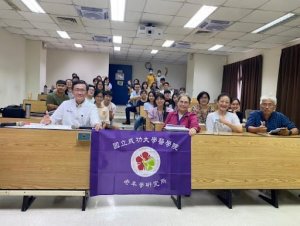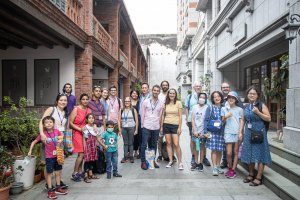This project, “Picturing Animals in Paris: Manet’s Bestiary and Naturalism” was conducted from August 2015 through July 2016, and made possible by the generous research grant from TUSA (Top Universities Strategic Alliance), Ministry of Education, of Taiwan, in association with Fairbank Center for Chinese Studies at Harvard University, as well as a partial grant from Fulbright Foundation. As a TUSA and Fulbright scholar affiliated to the Department of History of Art and Architecture at Harvard University, I have been able to expand the scope of my research in modern art and culture, as well as professional contact.
This project investigates the connections in Manet’s animal subjects and contemporary naturalist observations. As planned, I study how Manet depicted dog breeds and postures, as well as cat theatrics, in relation to the identity of personages, within the context of France’s response to the new interest in biology during 1830-1880. Manet’s bestiary shall be compared to contemporary illustrations of La Fontaine’s fables, primarily the works of J.J. Grandville, Gustave Doré and Eugène Lambert. Beyond that, I probed into the understanding of East Asian art in Manet’s circle. The project seeks to explain how Manet reflected the changing relationship of humans and animals within the context of urban life, as well as challenged notions of hierarchy and identity.
Manet demonstrated the close connection between animals and people through the association of boys and dogs, as well as cats at play, at times coming close to a chair. The interconnection between Manet’s animal pictures and Darwinism is particularly important to note. In the 1860s, French art criticism emphasized science with historical methods and natural science as two major axes of research. The impact of Darwin’s concept about the humanities and nature’s open patterns on French Avant-garde can be seen in the emerging science of children’s psychology, as in Bernard Perez’s observation of children and cat’s behavior. Contemporary trends in naturalism in turn influenced family education through children’s books. Eugène Lambert’s naturalist animal illustrations to La Fontaine (1870), distinguished from J.J. Grandville and Gustave Doré’s anthropomorphic imageries, may hint at interests in animal intellect.
At Harvard, I have been able to explore the recent scholarship in sociobiology as a new development in after Darwin’s biology. The studies on dogs’ and cats’ behavior allow me to build up solid observation of Manet’s depiction of animals. Biologists’ discovery about the raven’s mind also enabled me to look at Manet’s Raven and East-Asian inspiration as a major subject. A number of art study appointments at the Harvard Art Museums, reopened in July 2015, are crucial to my broader investigation in the late nineteenth-century French drawings and prints.
Thanks to the kind support of the Department of History of Art and Architecture, I have been able to make a number of trips to see many of Manet’s animal paintings in some major museums, including the Louvre, the National Gallery of Art in Washington, the Museum of Fine Arts in Boston, as well as the RISD in Providence. These trips also lead me to more contacts with art historians and Manet specialists. From April through July, I made a number of day trips to New York, to study the archives at the Morgan Library, and have been able to construct a more profound understanding of Manet’s life and art. Special exhibitions in New York museums, Degas, A Strange Beauty at the MoMA, are also crucial to my research findings.
The Department of History of Art and Architecture provides truly amazing professional support for my research. During the Fall semester, I joined Professors Suzanne P. Blier and David Bindman’s seminar, as well as their teaching exhibition “The Art of Jazz”, jointly held at the HAM and Cooper Gallery from February through May, and was able to contribute an essay on Matisse’s Jazz album and an introductory essay on synesthesia in the exhibition catalogue. I also learned very much from Professor Bindman in assisting him in editing the catalogue. More recently, I had the opportunity to collaborate with Professor Eugene Wang on the exhibition Sha Fei, an early twentieth-century Chinese photographer, held at the Fairbank Center for Chinese Studies in March-April. My introductory essay “The Body and Landscape in Sha Fei’s Photography” gave an overview of the modernist traits in the photographer’s works. This curating experience encouraged me to look at more Asian photographers and to undertake a new survey course on the history of photography in my home institute in the near future.
Beyond these research-related activities, I enjoyed particularly the company of some very nice colleagues and friends in Cambridge. I visited frequently on weekends the museums around Boston, including the RISD Museum (Providence, RI), Clark Museum (Williamstown, MA), Worcester Museum, Smith College Art Museum, etc., and learned so very much European and American painting. I also gave shared my expertise in this area by giving a talk on this subject, “Looking at Modern Art around New England,” to a New England Association of Chinese Professionals in May 2016. These trips also allowed me better understanding and enjoyment of the region. Some Taiwanese-American friends invited me to join their enjoyable community activities.
To conclude, this year of visiting scholarship at the Department of History of Art and Architecture, funded by the TUSA program in association with the Fairbank Center, as well as Fulbright scholarship, has been extremely constructive for my project and career. I have been able to finish two earlier papers on Manet’s images of childhood. Among them, the one on Manet’s Tuileries and childhood play was published this March. I am expanding the subjects of my drafts on Manet’s dogs, cats, as well as adding an essay on the raven. In March 2016, on a short trip to France, I gave a lecture on Brice Marden’s Chinese works, “L’écriture de l’imaginaire: les dessins de Brice Marden inspirées par des poèmes de Du Fu,” at the Université de Montpellier III, and also presented a paper on Taiwan’s Chimei Museum’s collection of western art works at the conference: Orient Extrême : collectionneurs et collections d’aujourd’hui, Ecole Nationale Supérieure de Lyon / Musée des Confluences, Lyon. I will also participate in the CAA annual conference in February 2017, to present a paper on Manet’s portraits of children, “Characterizing Intercultural Childhood: Manet’s portraits of Children and Bourgeois Families in late Nineteenth-Century Paris”. The collection of illustrated children’s books at Houghton Library also inspired a new project of mine on late nineteenth-century British book illustration. Above all, thanks to the affiliation with the Department of History of Art and Architecture, the opportunities of more art studies and professional contacts in the States are extremely significant to my research and teaching.







